Sales Engineering.
Leadership.
I'm Chris Kranz. I've built teams from 2 to 13 people across EMEA, and I've closed million-pound deals, and helped my colleagues close more. The best leaders never stop being practitioners. The best sellers never stop thinking like their customers. I'm always eager to learn from anyone that's willing to teach me something new.
Companies I've Worked With
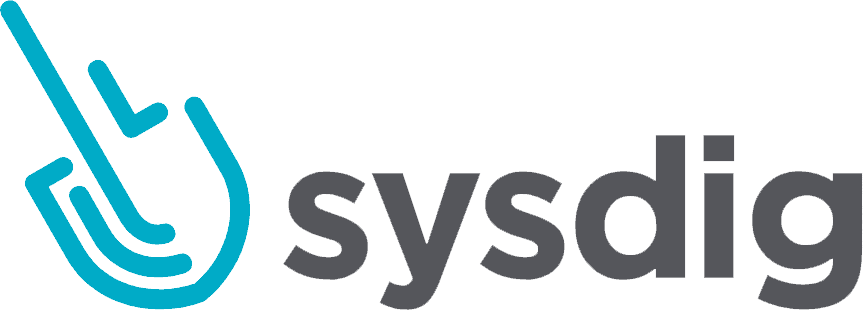
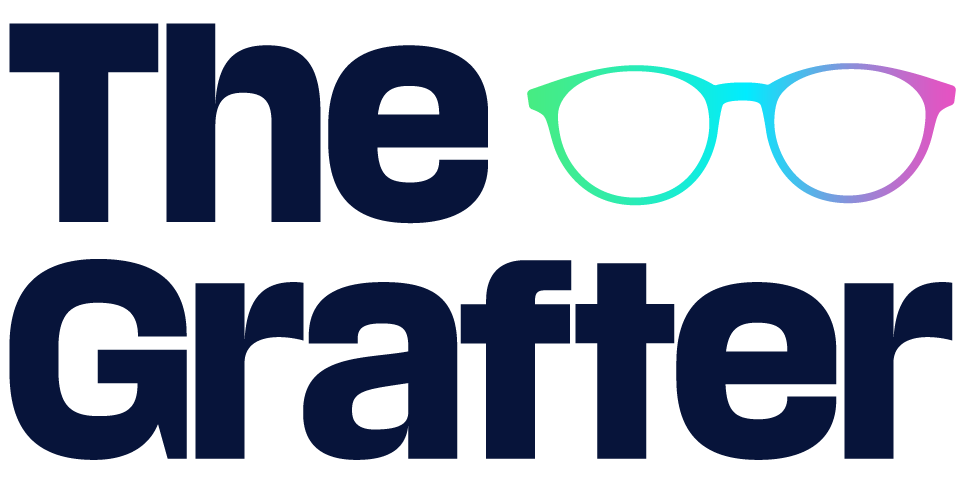




About Me
I fell into sales engineering the way most people do, by accident. I was the technical consultant who could actually talk to customers without making them feel stupid. Turns out that's a valuable skill!
Early in my career, I thought the job was about knowing the answers. Show up, demo the product, handle objections, close the deal. Simple, right? Except the customers who actually bought weren't the ones impressed by my technical knowledge. They were the ones who felt understood. The ones who said, "Finally, someone who gets what we're dealing with here."
That realisation changed everything.
I started leading with questions instead of answers. Understanding the customer's environment (not just their requirements) before proposing anything. Sometimes this slowed things down, folks had to think and sometimes reset their assumptions. But on the flip-side, it increased the close-rate and the deal size. And when I moved into leadership (scaling the EMEA SE team at Sysdig from 2 to 13 people), I tried to teach that same approach. The best SEs aren't the ones who know the most. They're the ones who listen the best, and ask the right questions at the right time.
But there's something else I learned being an SE leader: you can't do it well if you've forgotten what it's like to actually do the job. That's why I like to stay hands-on: running POCs, sitting in on discovery calls, closing deals myself. Not because I don't trust my team (far from it), but because the moment I lose touch with what's hard about this work, I become useless as a coach and a manager.
These days, I'm comfortable with either path (leading a team or being a strategic IC) depending on what the company needs. Both roles make me better at the other. When I'm working with customers, I learn what's actually hard about our product or their environment. When I'm coaching, I see patterns (positive and negative) across dozens of deals that I'd never spot alone.
What matters most for me is understanding the problem deeply, translating that complexity into simplicity, and delivering solutions that actually work in production. Everything else is just details.
Outside of work, I co-organize Kubernetes Community Days UK, speak at conferences, and mentor SEs and friends who haven't yet figured out we're all just making it up as we go!
I'm also known as "ck" when there are too many Chris's in the room, which happens more often than you'd think.
How I'm Wired
What Makes Discovery Actually Work?
I see so many SEs treat discovery like a checklist. "What's your current solution? What are your pain points? What's your budget? What features do you need?" Then they jump straight into demo mode.
Real discovery is about understanding the customer's environment, not just their requirements. It's asking "why" until you understand the actual core (5 Why's FTW!), not just the stated problem. The best deals I've closed started with discovery calls where I asked more questions than I answered.
If you don't know why something is hard for the customer, you can't position why your solution makes it easier. And if you can't do that, you're just showing features, and that's the path to losing on price.
Why Do I Stay Hands-On as a Leader?
I've seen and experienced SE managers who've been out of the trenches so long they've forgotten what's actually hard about the job. They coach from theory, not experience.
That's why I try to stay hands-on, even when leading teams. The moment I stop doing the work, I lose the credibility to coach it, and I lose the respect of my team.
The best leadership isn't "I'll tell you how." It's "Let me show you, then you try, then we debrief." You can't do that if you're only managing from Salesforce dashboards.
How Should Demos Actually Work?
Feature tours are boring AF. Customers check out after five minutes of "and here's another button you can click", or "here's my favourite feature" (kill me now!)
The demos that work are the ones that tell a story the customer recognises. "Here's what happens when your deployment breaks at 2am. Here's how long it takes to figure out why. Here's what that looks like with our tool."
That's why I've always built demos that support a story (shoutout to the "Cards Against Containers" game I've used on numerous occasions). Not because customers need to see something elaborate or different in a demo-app, but because they remember the story you told and how that relates to them, not the feature list you clicked through.
When Should Process Help vs. Hurt?
MEDDPICC and Command of the Message are useful frameworks. But too many teams treat them like mandatory forms to fill out instead of thinking tools to internalize.
The goal isn't to tick boxes in Salesforce. It's to change how you think during customer conversations. Once you've internalized the framework, you should barely notice you're using it, it just becomes how you naturally discover, qualify, and position.
If your team is spending more time updating deal fields than talking to customers, your process has become the problem.
What's the Best Way to Develop SEs?
Annual reviews are useless for developing SEs. By the time you're giving feedback, the moment is gone.
The best coaching happens right after the call: "That discovery was strong, but here's where you could have gone deeper." Or: "That objection caught you off-guard, let's role-play it for next time."
I learned more from debriefs straight after customer meetings than from any formal training. That's the culture I try to build: constant feedback, low stakes, everyone getting better together.
I built this into my standard team cadence: weekly or monthly we'd review their goals, their OKRs, their wins & losses, and we'd plan together how they could grow themselves (in whatever way was appropriate for them).
Build Things That Solve Real Problems
I like building things: demo flows, internal tools, processes that make life easier, etc. But I've learned to ship "good enough" and iterate, rather than waiting for perfect (perfect is the enemy of good).
The best tools I've built started as quick hacks that solved an annoying problem. Then we used them, broke them, fixed them, and eventually they became something polished. The worst things I've built were the ones I overengineered before anyone used them.
Same applies to team building. Don't wait for the perfect process or the perfect hire. Ship something that works, learn what breaks, iterate. Look for the potential of something that can be iterated on, not for "perfect" before you even start.
Is neurodiversity a super power?
It's not always a super-power, but I own it and I try to understand it better. That helps me get better, that helps me tell my colleagues the weird things that I find really difficult, and it helps me support my team & colleagues better.
I have AuDHD, which means I'm terrible at repetitive tasks and excellent at complex, constantly-changing problems. Sales engineering is perfect for this: no two customers are the same, no two deals follow the same path, and every POC requires creative problem-solving.
What some people call "easily distracted," I call "noticing patterns across different contexts." I see connections between a customer conversation last week and a product limitation I heard about yesterday. That's not distraction, that's how you build solutions that actually fit the problem.
The key is working with teams and companies that value variety over rigid process. Give me three different customer problems to solve and I'll thrive. Ask me to fill out the same form 47 times and I'll slowly lose my mind.
And I'd wager good money that a higher than average percentage of SE's are neurodiverse, so having a deeper understanding of that has always helped me manage with empathy. "What do I need to do to give you more of the work that helps you hyperfocus?"
My Key Impact
Revenue Performance
At Sysdig as EMEA SE & Leader:
- Consistently exceeded quota (120-140% attainment)
- Closed enterprise deals: £500K-£2M ACV
- Win rate on technical evaluations: 70%+ when SE was engaged early and we did value-based demos and PoV
- Presidents Club: 2019, 2020, 2021
Team Building & Leadership
Scaled Sysdig EMEA SE team from 2 to 13 people across EMEA and APAC.
- Highest retention in sales org (95% over 3 years)
- Multiple Presidents Club winners from SE team
- Built async-first culture across 4 time zones
- Promoted 3 SEs to senior roles, 1 to team lead
Customer Impact
Complex technical environments at scale:
- Led POCs for Fortune 500: financial services, SaaS, government
- Technical champions developed: 85%+ of qualified opportunities
- Reference customers secured with a number of happy customers
Process & Enablement
Built SE function from ground up:
- Created POV methodology & evaluation framework
- Developed technical discovery systems
- Onboarded over 100 AEs, SEs, & CSMs
- Mentored AEs, SEs, & CSMs globally
Thought Leadership
Active in technical community:
- Co-organizer: Kubernetes Community Days UK
- Speaker: Regional meetups & webinars
- Events: Booth duty & live demos
- Content: Technical blog posts, webinars, workshops
What Else I Bring
I've helped with product positioning, coached on pitch delivery, run internal enablement sessions, built demo environments that became marketing assets, and spoken at events to generate pipeline.
It's not always in my job description, but it's just what happens when you hire someone who cares about the whole GTM motion, not just their piece of it. I'm not a "that's not my job" person!
Work History

GTM Advisor
2024 - PresentThe Grafter
B2B founders usually know what they’ve built, but not always how to sell it. That’s where I come in. At The Grafter, I help founder-led teams sharpen their message, understand their buyers, and unlock real, repeatable growth.
I joined The Grafter as a strategic advisor and CRO, working with UK-based founders generating between £1–10m in revenue. These are often product-first businesses looking to scale, raise funding, or prepare for exit, but they need help making the commercial side click.
My role is a blend of coach, translator, and GTM architect. I lead The Grafter’s internal marketing and sales strategy, take first-line sales calls, and co-develop client-facing offers. Externally, I work hands-on with founders to define their ideal customer profile, shape value propositions, and build discovery-led messaging frameworks.
I've helped clients raise over £40m in non-dilutive funding, created business diagnostics to uncover hidden blockers, and coached teams to land six-figure deals by telling the right story to the right buyer.
I'm building confidence in teams who’ve never thought of themselves as 'salespeople'. Because great products don’t sell themselves, but great stories often do.
Why I Joined
I initially joined for a combination of an interesting and different chalenge, and also the flexibility that the contracting allowed while my family and I were still figuring out a different way & pace of life.

Father, Husband, Entrepreneur
2023 - PresentKranz Family & Polyvalent
Refocusing on family & personal projects to build a sustainable work-life balance. Building a number of micro-SaaS products that solve problems that I encountered in my life. Also taking on consultancy projects which included a regular video podcast (Post Cloud) and sales enablement consultancy to help build out discovery and product enablement programs.
After leaving Sysdig, I took a more primary role as Father and Husband. Duties include project management, damage limitation, education, travel logistics, mentoring, tantrum avoidance (~50% success rate), food preparation, supply chain management (trip and holiday organisation). Successfully made president's club each year (father's day and anniversary cards), although never received a pay rise. Managing a complex P&L budget. Work for an outstanding group of bosses, although multitasking between them is often challenging. Would not change this position for the world!
Later in 2023, I started building again but this time for myself. I setup Polyvalent to support my various projects. I eventually also took on several consultancy projects, assisting companies with go to market, enablement and customer outreach.
Polyvalent: having or using a lot of different forms or features
Polyvalent is a company that provides both go-to-market consultancy services (sales, marketing, technology, etc.), and also builds SaaS products that assist in these go-to-market activities (social media advocacy, solution selling, etc.). We are a bootstrapped company that focuses on user impact & benefit.
Why I Joined
I needed time to recharge after Sysdig, and wanted to explore some of my own technical skills.
Polyvalent
Company homepage
Proof of Value
Micro-SaaS to allow sales teams to dynamically build test plans that suits what a customer actually cares about instead of delivering generic and standardised plans that may be 90% irrelevant.
Breaking OutOfThis NetWork
Micro-SaaS Platform that allows marketing teams to share messages with a team of social sellers / brand ambassadors / etc. A focus more on allowing the users to use their own voice and personalise the message for their own audience.
Fabulist
A story telling platform for parents / carers. Allows for customised stories where the child is put directly into the story itself, or guided generation of unique stories.
Post Cloud Podcast
Also available on YouTube and various audio podcast platforms. Co-Hosted, produced and edited this podcast which focused on Cloud technologies and where the industry is going next
GeekSnap
A relatively quick bit of fun, a visual game where you look for the matching product icon between 2 cards.
CardsAgainst.io
Currently undergoing a rewrite - An online version of the physical Cards Against Containers that I helped build while at Sysdig.

Director of Technical Enablement
2021 - 2023Sysdig
Sysdig needed to scale fast, but most sales hires didn’t understand cloud security. I was hired to solve that. I built global enablement programs from scratch, rolled out customised sales methodologies, and helped over 100 new hires become confident in selling complex cloud-native tech.
In late 2021, I stepped into a global role to lead enablement across Sales, SE, and CS. We needed to onboard over 100 new hires fast, many with little cloud experience. I built INK (I Now Know), a bootcamp that mixed live sessions, recorded content, and hands-on coaching.
Alongside onboarding, I rolled out MEDDPICC and Command of the Message globally, adapted to our product language. These were embedded in Salesforce workflows and used as the basis for deal coaching and pipeline reviews.
We also rebuilt our Sales Kick-Off (SKO) experience: pre-work was digital, on-site was interactive. I led workshop design, coaching games, and playbooks. Feedback scores from SKO were among the highest ever.
Across 2021–2023, over 90% of President’s Club reps had gone through enablement I led or designed. From the pictures I see on LinkedIn and comments from old friends, a significant number in 2024 and 2025 had also been through my work.
Why I Joined
As the company grew, I was approached to take this on as a world-wide role. I loved my team and wouldn't have hesitated to keep managing it, but I wanted to bring more value to the company and this felt like a great opportunity to do that.
Command of the Message Intro
While the content was produced for internal consumption, here is an example of some of the CotM messaging that was adapted for internal use.
Open Session - Industry Primer
I ran regular open sessions for new hires (and anyone else who wanted to join) to help them understand the industry and the challenges that customers face.

EMEA Sales Engineering Manager
2018 - 2021Sysdig
Sysdig was growing, but as a US based company, they were struggling to manage a world-wide team. I was promoted to help cover EMEA, including teams in Singapore and India. We grew the team from 3 to 13 before I moved on, and had staff across the region. We were fully remote and usually worked asynchronously. The team had a hugely supportive culture, and we extended our virtual team to include customer success and support. We had the highest retention world-wide, and some of the best performers world-wide too. Our team helped grow Sysdig significantly in the region and expand our presence across partners, customers, and the open source community.
I joined Sysdig as one of the first in the go-to-market team in EMEA + ASEAN and lead the Sales Engineering team. At the time it was a total team of 4. Over the next 6 months I helped grow the team to 8 and worked closely with the new VP of EMEA to build and expand Sysdig's EMEA + ASEAN presence. We managed EMEA + ASEAN (Japan reported into North America and ANZ was not yet established).
Partnering closely with the VP of EMEA and the Director of Partners, we grew the EMEA business to exceed the expectations of the US teams and punch above our weight in deals won and partners brought on board. This led to achieving Presidents Club for the first two years that it was run (the 3rd year I switched to the Enablement team).
In 2020 we adopted Command of the Message. I was part of the initial design team, and over the next 3 years continued to be involved in updated and adapting the framework. I worked closely with the VP of EMEA and the other EMEA Sales Directors to help with deal coaching, MEDDPICC analysis, and generally work to mentor the sales team with the sales cycle and different tactics to be used. This wasn't always clear sailing and there was some resistance to adopt the framework. However, where it was applied we saw an increase in average sales price, and a decrease in sales cycle length. I also used Gong extensively for call and opportunity coaching.
In 2020/2021 we hit some key milestones and the business decided to grow moe aggressively. I helped interview most of the new reps in EMEA, as well as assisted with their onboarding. I personally grew the Sales Engineering team from the initial 4, to 13. During this time the ANZ team was established, this meant I was able to focus more on EMEA. This ended up being split between Enterprise and Corporate (SME / Commercial), so I worked closely with the VP of EMEA who was focused on Enterprise, and the 2 Sales Leaders for Corporate. Several of my team also made Presidents Club this in 2021.
Why I Joined
I knew some folks that had joined in the US, and the product was solving problems I was directly experiencing at Vocalink.

Product Manager (contract)
2017 - 2018Vocalink
Vocalink is a fundamental core part of the UK banking system, but the company had a challenge: How can we grow the business given we already have significant market share of the UK? The solution was to be able to package up their payments platform and deliver this around the world, expanding their market offering. I was brought in as part of a team tasked with building this platform. Packaging up an application to make it portable and repeatable meant we were building a containerised platform and needed everything to support this. This meant CI/CD, observability, security and of course Kubernetes. The portable payment platform was launched and delivered to the first non-UK customers.
I joined Vocalink to help build a new containerised platform to support the adoption of their payment platform globally. The business (driven by the CEO) realised that to grow it needed to be present in more than just the UK, so a team had been setup to modernise their payment platform and create a portable way to be able to deliver this to different countries around the world. This project had already been ongoing for a number of years, using various external consultancies. When I joined, a team of contractors was working under a number of consultants who were promoting and driving business change.
To make the platform portable, easy to deploy, and easily managed / updated, the obvious choice was to build a containerised application. Initially we looked at Rancher and Docker Swarm. We started with Rancher and then moved to Kubernetes. The platform was supported by Prometheus for monitoring and Elasticsearch for logging. The application stack was mostly Java.
My role was largely as a Scrum master and DevOps lead. I handled much of the design work and running the sprints. We did 2 week sprints with retrospectives, demos, 3 amigo brainstorming and regular stand-ups. Due to the regulatory requirements of the business, almost all work was handled in-person in either London or Rickmansworth, with occasional sessions in Harrogate.
I reached out and worked with the procurement team to establish a relationship around any potential product purchases. I also worked with legal to ensure we were engaging with vendors correctly. The security team was mostly an advisory function, but I setup several sessions to keep them informed of what we were doing, and asked if there were any potential unseen challenges or concerns from their side.
Despite the project being driven by the CEO, it was an unfunded one. This meant that I had regular meeting with the wider project team and the CFO to understand the budget and business benefits. This included the financial benefits which would be used to justify the project costs (including my own!).
Why I Joined
I was looking for something with more hands-on experience of Cloud-Native and microservices, and a friend had recently started working here and referred me in.

Solutions Architect
2016 - 2017Hedvig
I joined to partner with the UK Sales Director, under the existing VP of EMEA and EMEA Director of Sales Engineering. Within 6 months, the EMEA team left, and within 12 months I was the only person of the sales team in EMEA. I managed to close the only deal in EMEA, despite having limited sales support. I took part in Tech Field Day, as well as many webinars creation of explainer videos.
Hedvig was my first Silicon Valley start-up experience. Although I had worked for small and developing companies in the past, Hedvig was the first that was VC backed and led out of California. The company was founded and led by Avinash Lakshman, the co-creator of AWS DynamoDB and Cassandra. Hedvig was built on top of the Cassandra idea, so a massively distributed storage platform that handled CAP theorem across a quorum number of locations.
Given lack of sales and opportunities, most of my time was spent working closely with marketing. I built a number of showcase videos, explanatory guides, whitepapers and other public facing assets. I was also involved in Tech Field Day in Santa Clara, California. I worked closely with Engineering and the Executive team, providing customer and industry feedback, and helping develop the future of the product.
Unfortunately lack of sales and technical customer fit led me to finally leave after 18 months. I built several great friendships while at Hedvig, some that eventually led me to join Sysdig.
Why I Joined
A friend was looking to join to lead UK sales and asked me to join. The story of the company and Avinash was really compelling and fascinating!
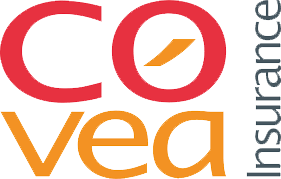
Technical Architect (contract)
2015 - 2016Covéa Insurance
Assisting the team with the design, deployment and transition of a new infrastructure to support a new business initiative. Working with VMware, Tegile, Cisco UCS, Cisco Nexus, Zerto and Veeam with lots of PowerShell. PowerShell automation work both for environment automation and auditing / health checks, integrating across various APIs and modules (including F5, RabbitMQ, Active Directory, VMware and a few others).
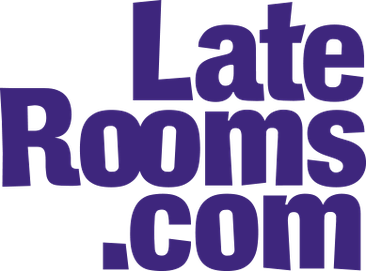
Infrastructure Architect (contract)
2014 - 2015Laterooms
Brought on to assist with several transformation projects within the business, including driving data centre efficiencies, strategic use of IaaS (both private and public), unified communications, PCI-DSS, Active Directory consolidation and other projects. Assisted in setting standards for consumption of AWS cloud services, as well as migrating specific services into Route 53, EC2 (for development and disaster recovery) and S3. Worked closely with the contact centre team to select, negotiate and migrate to a cloud telephony platform, including a fully managed IVR, ACD and secure credit card handling.
Spent a lot of time working across the business, selecting and working with stake-holders in building project documentation and business cases to be presented to the board. Working closely with the project management team to refine business cases and project planning. Lots of involvement with the DevOps community in streamlining the transition from code to infrastructure, working alongside Go and Chef pipelines to enable a much quicker delivery framework. Initial investigations into containerisation of code within wrappers like Docker. Small amount of Node.JS and bash coding to automate AWS services.
Why I Joined
The mix of dot-com foundation, and cloud technology use really fascinated me.

Practice Lead
2011 - 2014Kelway (now CDW UK)
Kelway are rapidly becoming one of the UKs leading system integrators / value-added resellers. In addition to the very successful fulfilment business, in 2011 they committed to growing in the services and solutions areas and I was employed to help develop and build this. Working across multiple technologies including a primary storage focus on HDS, EMC, HP, IBM, Dell and NetApp solutions, with VMware, Cisco, VCE, Citrix, Redhat and Microsoft virtualisation and Cloud solutions. I was responsible for working on some of the key accounts within Kelway and working closely with the projects team to assist these customers through various programmes of change. Many customer meetings were focused around white boarding the different solution options available with little preparation and ensuring that the customers' requirements were clearly recorded and met by any solution proposed. This in turn developed into designing the project and ultimately becoming the technical design authority during the implementation.
As Practice Lead I directly manage around 10 Solutions Architects, ensuring they have the focus to work on customer projects and that their lives are as simple and worry free as possible! Not always a direct management role as the team are very self sufficient but mainly acting as a firewall to keep politics and problems away from them. I regularly arranged team events, set the strategy and gave individuals training and business objectives to complete. Assisting where appropriate with projects and workload to maintain the teams high quality and profitability to the business.
Why I Joined
Having previously been solely focused on NetApp and VMware, this was a great opportunity to be exposed to wider technology stack, but also lead a team with wider experience of data centre technologies.

Technical Consultant
2005 - 2011B2net (now Proact)
Senior NetApp Consultant working to deploy all the largest projects on all levels of systems. Specialising in minimising downtime and impact of any project
Senior VMware Specialist working to deploy many environments in excess of 200 VMs
Assisted many customers design complete DR policy and how this can be automated with existing NetApp and VMware technologies
Consulting role working to win new projects with customers who are existing VMware or NetApp users but require more of a technical deep dive and troubleshoot complex architectures
Designed, deployed and managed a custom support infrastructure to support around 500 NetApp systems (B2net are now ASP certified in part due to this work)
Custom scripting using PHP and BASH to assist customers to fill management and automation gaps before projects and technologies filled this
Acheived VCDX (VMware Certified Design Expert) in 2010, becoming one of the first 50 worldwide to achieve this.
Why I Joined
I initially joined as IT Manager, but quickly learned about NetApp and VMware and become a Technical Consultant.

Web Developer
2000 - 2005Various
Before 2005 I had various roles as a web developer and web designer. I learned HTML, CSS and Javascript, expanding this with PHP and MySQL, mostly using Linux servers. I built a number of bespoke websites and intranet applications, all of which have been long since replaced! I mostly worked for smaller organisations, including 18 months in the Caribbean working on various tourist company websites, building and managing an intranet for a print company, and working for a web development agency.
What People Say
His style and mannerisms are well received and he's often the go-to-guy for all matters relating to enablement and even wider K8S questions - always available and ready to help out. Further, his output is always professional and detailed.
Great knowledge, positive, wonderful cross functional collaborator, he also has the ability to bring the tech talk down a notch when presenting and explaining to non tech employees, so we can understand and own the topics. Great advocate!
CK is not afraid to ask the hard questions and even argue a bit! I love that. It's easy to just go along with what a leader or the group thinks, but CK intentionally tries to think the opposite of everyone else.
CK is amazing at translating really complex technical problems into digestible bite sized stories. This is really important for our team and industry.
Chris is always available to provide mentoring and assistance whenever needed, and he does that with a very positive attitude. He has helped me actively in producing some effective training material, despite my limited previous experience on the matter. It indeed is a pleasure to work with CK.
High energy, motivation and engaging personality - you can tell CK has a real passion for his role and the expertise to be able to deliver.
Chris Kranz knows how to engage with people and drive a conversation in a productive manner, and he also knows how to teach others to do the same. His deep understanding of Sysdig's solutions, technology and market, together with his generous personality makes him also a dependable and trustworthy interface for those ramping up or anyone that needs help to understand something about our solutions. He is a natural when it comes to building relationships.
Chris is a true modern Renaissance man. He is a multi-hyphenate in the tech space. He is incredibly technical (don't let his humility fool you) and he's well versed in the realm of sales methodologies and enablement. He's also the best teammate. You'd never hear "that's not my job" from Chris. If anyone needs anything, he will do his best to help. Chris's work product is always superb. He is also an incredibly kind person. It's not always easy being a woman in tech. Chris made it very clear, from the first time we spoke, that he was in my corner. He's a true ally to the underdogs. He would be an asset to any team.
Beyond his professional contributions, Chris is a great human being. He infused our workplace with a sense of camaraderie and respect, and his departure has left a significant void. He managed to strike a balance between being a leader, a mentor, and a friend, which is a rare quality. Even although we weren't always sharing the same opinions and views, I enjoyed our conversations as well as the help to see the things from different perspectives which helped me personally as well as from the business perspectives (I will miss our conversations, Chris!).
Chris was my manager when I joined Sysdig 4 years ago, and I must say also a mentor. We share the same vision of management, a mix of leadership, trust relationship, and excellence in execution. During the years spent together at Sysdig, I was amazed by Chris's ability to learn, read, have an opinion, about a vast horizon of subjects. When he picks a subject, you can be sure that he becomes an expert of it in a glimpse. He is one of the bests, if not the best, manager I had in my carrer.
I worked with Chris for 2 years, reporting directly to him for one of those. He has a great experience both in value selling and in people management, being able to lead, mentor, teach and guide his team to the achievement of the objectives in a really balanced manner. His tireless dedication to the role and his organized approach make him one of the best professionals I ever had the chance to work with, and I'm sure Chris may represent an incredibly valuable resource for any company he will join.
CK is an exceptional presenter who can effectively communicate new and complex concepts (sales methodologies, product, process, value enablement to name a few) to a diverse audience, including account executives, BDRs, customer success, and sales engineers.
It was a great pleasure to work with Chris in the last 2 years. His ability to explain complex technical concepts in a simple and understandable manner is truly impressive. As EMEA SE Manager, Chris was responsible for leading a team of Sales Engineers, and under his leadership, the team consistently exceeded their targets. Most recently, as Director of Technical Enablement, Chris developed and delivered technical training programs for the company's sales and technical teams, ensuring that they had the skills and knowledge they needed to successfully sell and support the company's cloud security solutions. I am highly confident that Chris would be an invaluable asset to any organization.
I've had the pleasure of working with Chris for the last four years. We worked closely together when he led the Sales Engineering Team in EMEA and more recently in his role in Sales & Technical Enablement. Chris is extremely passionate about everything he does and will go out of his way to help others. Chris did an amazing job of initially implementing and enabling the sales and technical sales teams with Command of the Message in EMEA. Outside of his role, he is someone I've often leant on for help, whether it be reviewing deals, account plans, messaging or providing coaching and advice for my team. With Chris' help I could be confident that that my team were clear in their understanding of an opportunity and what value a prospect / customer could extract from us. Chris is a real asset and is someone I can wholeheartedly recommend for any future role.
Chris is a fantastic work colleague - to say he gets stuff done would be an incredible understatement. He is also very thoughtful and creative, a very inspirational person to have on your team. In front of customers, he creates confidence, is equally comfortable in both the technical and business domains, and is agile and able to think on his feet. Wholeheartedly recommended.
It's very rare to work with someone whose brain is equal parts technical and creative, but that's CK! He is a master at collecting people's ideas and stories and he uses his technical expertise to create assets that are useful to sellers who may not know much about our industry. For instance, CK collaborated with sellers to collect customer stories and then broke these stories into bite sized pieces that sellers can use in their calls.
I was privileged to be able to work with Chris over a number of years whilst he was at Kelway. Chris was and is an outstanding person to work with. As a mentor he helped shape my understanding of the industry and showed that understanding business drivers and application of a proven methodology are key to delivering solutions and designs to customers.
Chris always was on hand to offer great support and advice through his knowledge, experience and abilities around cloud, virtualisation and storage. His management abilities and organisational skills are to be applauded for his first Kelway management position.
Chris is a great mentor and thought leader whom I have had the fortunate experience to have worked with for 7 years now, it's fair to say that it is rare that you will come across such a standout talent. Not only is he an expert in his specialist areas but he also bring an extremely high level of integrity and is great at managing stakeholder expectations, whilst having the aptitude to grasp any technical or business requirement with his broad-minded, strategic mind-set. In the time that I have worked with him, I have always been impressed by his thorough, creative approach to his work. He is an outstanding advocate for improving the experience of IT Services, and for finding ways to make technology work better for business and consumer. Chris is adept as a public speaker with ability to inspire large audiences with his unending enthusiasm.
I have worked with Chris on a number of occasions and found him to be very knowledgeable. Chris is good to work with and has an easy manner that make him very approachable. When we asked Chris to sanity check our environment his thorough knowledge of virtualization and storage helped us to implement changes for the better. I would recommend Chris for any position and I hope to work with him again in the future.
Chris Kranz is a very capable and technically gifted individual. He's the only VMware VCDX certified specialist I know, but far from being a one trick pony, knows NetApp, EMC, SQL, Exchange, Windows AD and who knows what else! Chris is one of those people who is always willing to help others and the first to respond to his colleague's queries. He was very highly regarded within B2net by the technical and sales teams. He is one of the smartest people I have had the pleasure of working with and I have no doubt he will do very well in his new role.
Chris has a technical ability second to none. I have worked alongside Chris for over 6 years and he has always had a zest for mastering new technical challenges. He is a great asset to our technical team and I have found working with him highly enjoyable.
Chris was a key member to deliver a complex migration of servers and storage at the Manchester Evening News into a VMware estate with Netapp storage. Migration completed on time and on budget. Chris knowledge, reliability and direction was unvaluable before during and after the project. Easy to recommend such a great professional.
Chris is a first rate IT consultant. A great person to work with whether you want him to sell technical solution, design them and above all implement them to the highest of standards. He has wide ranging technical skills and being at the forefront of ensuring that the company is at the cutting edge of his specialist technologies. I'm really pleased for Chris to have recently stepped into the elite group of people in the world to have gained a VCDX qualification from VMware following months and months of hard work and dedication. Furthermore, Chris is always fun to work with too which is a great added bonus, brining bags of fun and personality to every project. He is a great team player and always there to offer guidance and support to the most impossible of issues and risks we encounter with a tireless attitude to work to fix it personally at any hour of the day.
In my experience, Chris has unparalleled knowledge of NetApp and VMware technologies. I know that when Chris is assigned to deploy a virtualisation solution I have designed that the project will go well. I get excellent feedback from customers where Chris has been involved - he also has the rare ability of being able to share his knowledge in a way that 'normal' people can understand!
Integrity, professional, knowledgeable and innovative are just a few words to describe Chris Kranz. He is a role model NetApp community member (was one of our initial Featured Members to help keep the bar high) and continues to enrich the community with his insights, solutions and overall expertise. Chris is one of the few members who has a dedicated blog within the community. I am consistently impressed with the way he explains and highlights technical topics in a refreshing candid manner. This type of openness is exactly what NetApp represents and appreciates in any partner relationship.
Chris is an exceptional and gifted talent, it was a great loss to the IT Department when Chris moved to pastures new, and a considerable gain to his new employer! I would say Chris is an asset for any coprporation, and given the opportunity I would not hesitate in working alongside Chris again, Number 1 in my Headhunt List for the future.
Chris has been one of my top members on the NetApp Community sense the start. He is always willing to help other members out and is one of the most knowledgeable NetApp experts out there. His great personality in person and offline make it a great experience to work with Chris.
You only have to look at Chris's in-depth responses to the NetApp community to realize he is a technical guru. In person, Chris has the calmness of a sage which belies his Ferrari like mind, and the eloquence of the conversations to ensue makes him a Top Gear champion. Chris is an extremely competent consultant. I absolutely relish every opportunity to work with Chris
Chris' technical skills have rapidly grown within B2net and he is now considered as a subject matter expert in storage, virtualisation and many Microsoft technologies. Chris' skills and experience are used to help steer the direction of the technical team in these areas. Chris is also acting as an excellent and respected mentor for many of the junior members of the technical team.
I have never met anyone quite like Chris before. With some IT professionals, a technology specialism is something they work hard to attain and maintain. Chris seems to have them all! He is a senior level technician across all disciplines, combined with an immensly likeable character. No wonder that customers and colleagues all treat him with a great deal of affection. Quite where he finds the hours in the day is beyond me. A fantastically hardworking, professional team player. Highly recommended!
Community & Fun
Beyond work, I'm active in tech communities, create educational content, and occasionally make satirical tech songs and parodies.
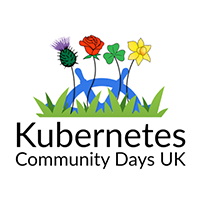
KCD UK
One of the organisers for KCD UK, focusing on sponsorship and social media engagement.
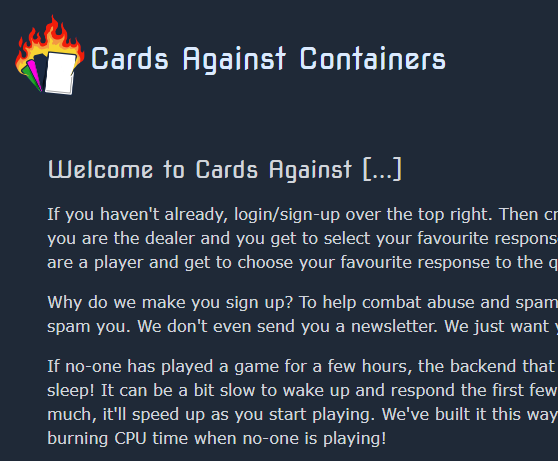
Cards Against
Inspired by the card game, I created an online version during lock-down, and then more recently refactored it into serverless, although I keep promising I'll add more decks!
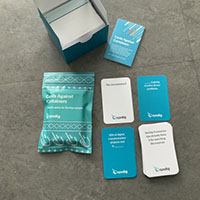
Cards Against Containers
A marketing game I developed at Sysdig to provide a Cards Against Humanity style game based on containers and container security.
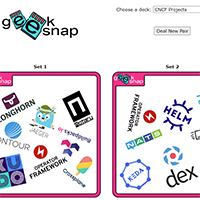
Geek Snap
A simple Dobble clone to match techonology symbols and logos.
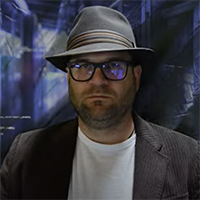
Reply Guy
A satirical take on women often being targetted on social media by 'Reply Guy' type people.

Tainted Node
A popular rework of the song 'Tainted Love' by Soft Cell, focusing on Kubernetes.

21st Century Kubernetes Boy
A modification of the song '21st Century Digital Boy' by Bad Religion, focusing on Kubernetes.
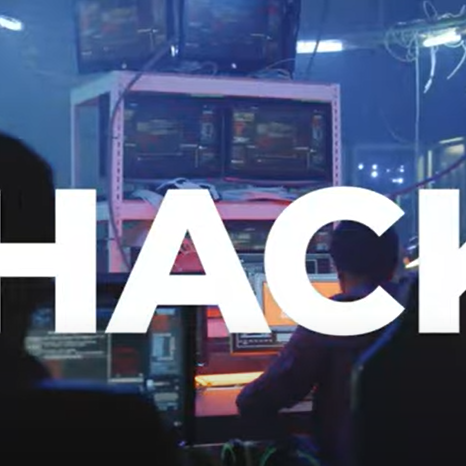
Hack
A satirical take of the song 'Creep' by Radiohead, focusing on hacking and security.

I Will Survive
A rework of the song 'I Will Survive' by Gloria Gaynor, focusing on adapting to commercial changes to a certain container hosting service.

London Calling KCD UK 2022
A modified version of 'London Calling' by The Clash, focusing on KCD UK 2022.
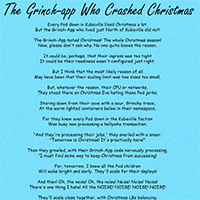
Christmas Poem 2019
A fun Christmas poem about the Grinch and Kubernetes.
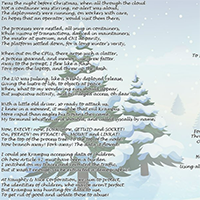
Christmas Poem 2018
A fun remake of a Christmas poem based on 'The Night Before Christmas' by Clement Clarke Moore.